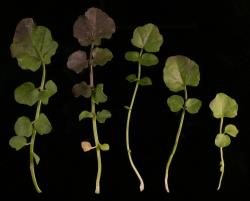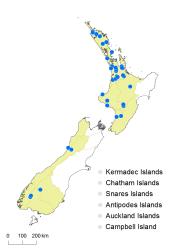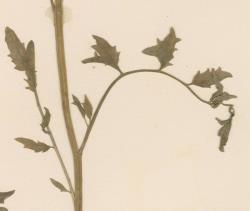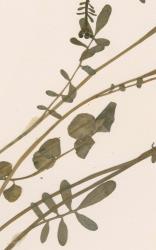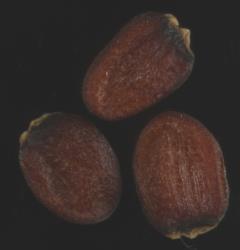- Taxon
- Gallery
Perennial herb, single rosette or with short lateral branches, rhizomatous. Leaves up to 110 mm long, pinnatisect; lamina 30.0–82.0 × 15.0–23.0 mm, green, membranous, glabrous or sparsely hairy; hairs 0.1–0.4 mm long, appressed to spreading; petiole up to 30 mm long. Terminal pinna 5.5–25.0 × 5.8–25.0 mm, larger than lateral leaflets, simple, orbicular, broadly orbicular, orbicular-reniform to broadly orbicular-reniform; margin entire, sometimes shallowly lobed, with 2–6 usually indistinct hydathodes; apex obtuse to retuse, usually with an indistinct hydathode; base weakly cordate, truncate or obtuse. Lateral pinnae 6–14, 3.0–18.0 × 3.0–17.0 mm, orbicular to broadly orbicular, margin entire or sinuate, apex obtuse or subacute; base weakly cordate, truncate to obtuse; petiolule 0.3–1.5 mm long, occ. ± sessile. Cauline leaves narrower, smaller and with fewer pinnae than rosette leaves; pinnae narrow-elliptic to linear, margins entire, bases attenuate to obtuse, glabrous, rarely ciliate; terminal pinna up to 35.0 × 4.8 mm; lateral pinnae up to 24.0 × 4.6 mm. Inflorescence racemose, 2–13-flowered; peduncle up to 350 mm long, 0.8–1.2 mm diam. at base, erect to ascending, purple or green, glabrous. Pedicels 8.0–30.0 mm long, 0.25–0.5 mm diam., glabrous. Sepals 2.5–4.0 × 1.0–2.4 mm, elliptic-oblong, saccate, green or green-pink, glabrous; margin white and membranous, apex obtuse, base truncate. Petals 4; 7.0–11.0 × 2.1–6.0 mm, pink or white, limb obovate; apex obtuse; base attenuate to cuneate, tapering to a claw up to 2.3 mm long. Stamens 6; median filaments 4, 3.2–4.0 mm long; lateral filaments 2, 2.0–2.7 mm long; anthers 1.0–1.3 mm long, cream to pale yellow, when dehiscent held above the stigma. Ovary 2.8–2.9 mm long, 0.5–0.6 mm diam., ± terete, green, glabrous; ovules 12–20; style c. 0.2 mm long, ± terete; stigma 0.4–0.5 mm diam., white. Siliques 10.0–32.0 × 1.0–1.7 mm, pale yellow-green, valves often purple, glabrous, style 1.0–1.7 mm long; replum 0.4–0.6 mm wide. Seeds 1.5–1.7 mm long, 1.1–1.2 mm wide, 0.4–0.6 mm thick, broadly oblong to orbicular-oblong, red-brown; wing present or absent around margin.
North Island: Northland, Auckland, Volcanic Plateau, Taranaki, Southern North Island.
South Island: Westland, Southland.
Naturalised in New Zealand. In the North Island C. pratensis occurs in Northland, Auckland, Volcanic Plateau, Taranaki and Southern North Island, and in the South Island in Westland and Southland, predominantly in higher-rainfall western areas. Cardamine pratensis is originally from Europe, where it is widespread (Zozomova-Lihova & Marhold 2003).
Cardamine pratensis occurs in shaded and/or damp sites such as river banks, lake edges, swamps and boggy areas, track edges, and amongst open scrub and shrubs, low herbs and grasses.
Allan (1940; see also Garnock-Jones 1979) gives the first record as being from Whāngarei (North Auckland). The specimen supporting this record has no collector and is undated, but it does have a supplementary label added by A. J. Healy on 20 August 1946. This supplementary label implies the specimen may have been received at the herbarium for identification from an “Inspector of Stock”, Whāngarei (North Auckland), on 16 October 1936. Two other early records are a specimen collected from New Plymouth (Taranaki) on 27 November 1936 by V. D. Zotov (CHR 17295), and another specimen collected from Palmerston North (Wellington) on 21 November 1937 by H. H. Allan (CHR 19086).
Flowering September–June; Fruiting October–June.
Cardamine pratensis "toothed-leaved form": In New Zealand a tooth-leaved form of C. pratensis is only known from the Hauraki Plains, North Auckland, where it occurs in swamps and grassland. It is distinguished from the more typical sinuate margin / entire-leaved form of C. pratensis by more numerous leaflets that are prominently toothed, the silique is slightly more slender and with a longer style, and the seeds are oblong rather than being rounded.
Leaves with 16–24 lateral pinnae, broadly elliptic to elliptic-ovate and margin toothed, base cuneate to obtuse. Cauline leaves narrower, smaller and with fewer pinnae than rosette leaves, entire or with 1–2 teeth; terminal pinnae up to 17.0 × 1.8 mm; lateral pinnae up to 15.0 × 1.2 mm.



